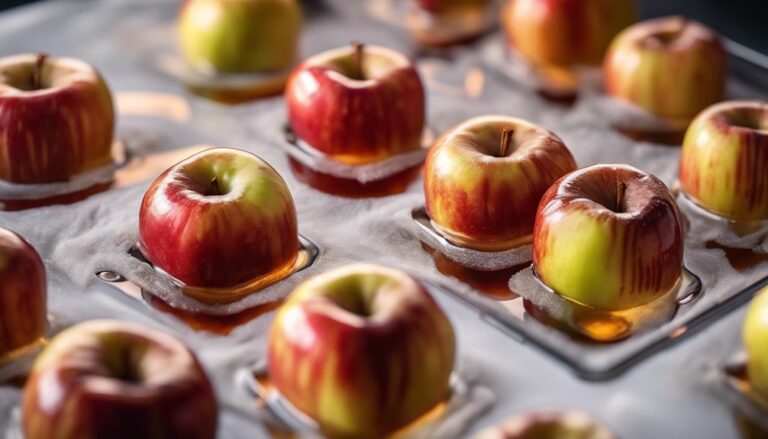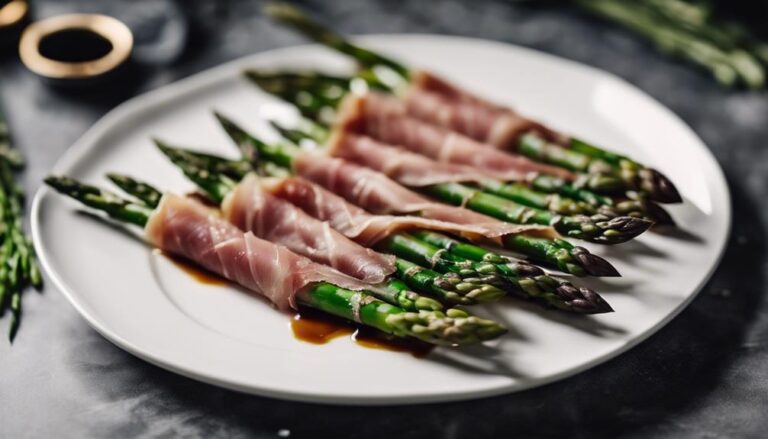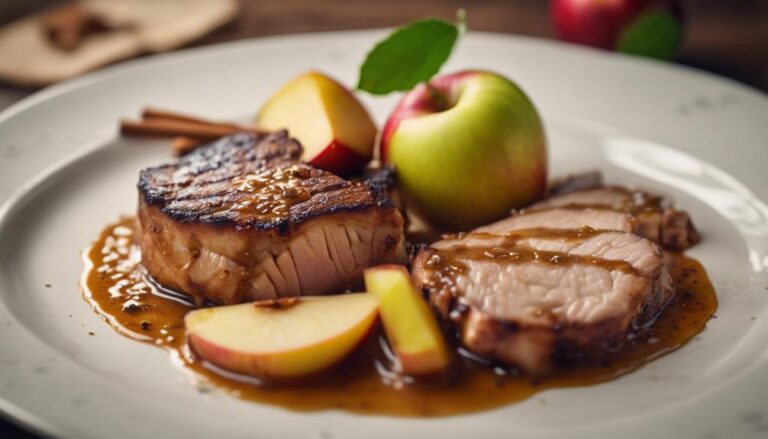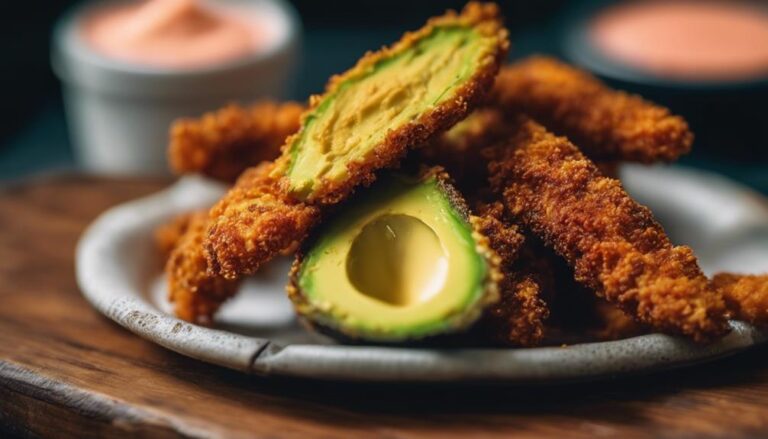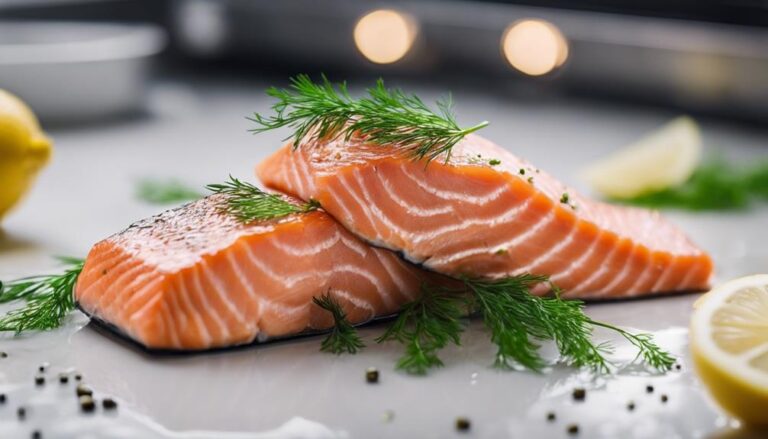Sous Vide Grass-Fed Steak With Rosemary
Immerse your grass-fed steak in a sous vide bath for tender perfection, infuse with fragrant rosemary. This method guarantees precise cooking, locking in juices and flavors. Sear briefly to achieve a crispy exterior, preserving the rich taste. Elevate your dining experience with this sophisticated blend of textures and aromas.
What You Will Learn Here
- Sous vide grass-fed steak for precise doneness.
- Infuse with aromatic rosemary for enhanced flavor.
- Maintain moisture and tenderness during cooking.
- Highlight natural grass-fed beef flavors.
- Experiment with seasoning for personalized taste.
Steak's Evolution Over Time
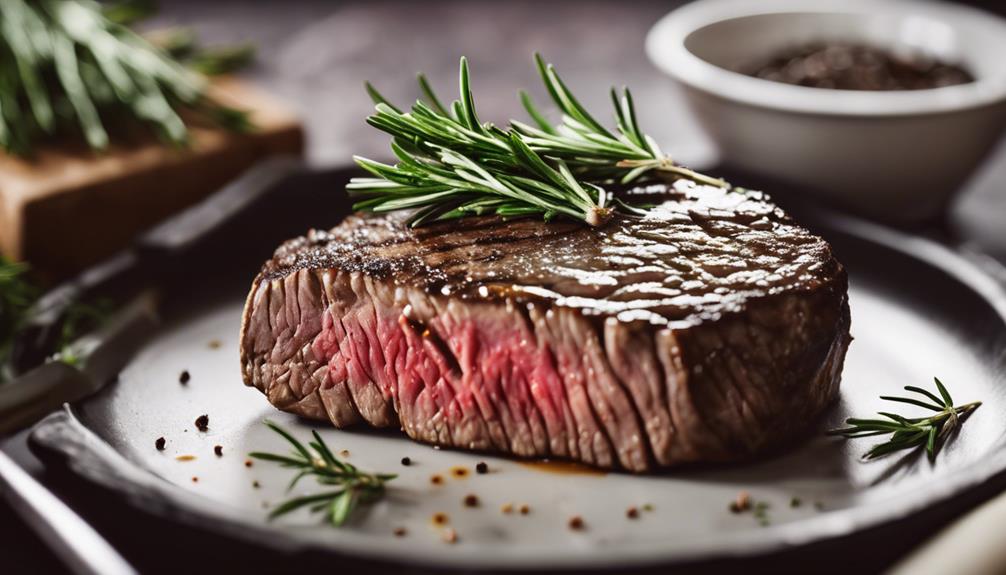
Explore the rich tapestry of steak's journey through time, from its humble beginnings to its current status as a culinary staple.
Consider the historical methods of preparing this beloved dish, contrasted with the innovative cooking techniques that have revolutionized steak preparation in the modern era.
Investigate the intriguing flavor profiles and variations that have emerged over the years, shaping the way we savor this classic meal.
Historical Steak Preparation
Over the centuries, the way steak is prepared has undergone significant changes, reflecting shifts in culinary preferences and cooking techniques. Historical techniques for preparing steak varied greatly across cultures and time periods.
In ancient times, meat was often cooked directly over an open flame, with minimal seasoning to enhance the natural flavors. As culinary traditions evolved, different methods such as pan-searing, grilling, and roasting became popular, each bringing its unique textures and flavors to the dish.
The advent of marinades and spice rubs further expanded the flavor profiles of steak, allowing for experimentation and customization. These historical practices laid the foundation for modern steak preparation, influencing the techniques and approaches that are still used today.
Modern Cooking Techniques
Modern steak preparation techniques have evolved greatly over time, incorporating innovative methods and technologies to enhance flavors and textures. Culinary innovation and cooking technology have played significant roles in this evolution.
Techniques such as molecular gastronomy and precision cooking have revolutionized the way steaks are prepared, allowing for precise control over temperature and texture. Molecular gastronomy, with its focus on scientific principles and experimentation, has led to the development of new cooking methods that push the boundaries of traditional steak preparation.
Precision cooking, on the other hand, guarantees that steaks are cooked to perfection every time, resulting in consistently delicious outcomes. These modern cooking techniques have transformed the steak culinary landscape, offering a new domain of possibilities for chefs and food enthusiasts alike.
Flavor Variations Observed
With the advancement of modern cooking techniques, the evolution of steak preparation has resulted in a myriad of flavor variations observed over time. Flavor profiles have become more nuanced, with chefs experimenting with different cooking times to achieve the perfect texture and taste.
Sous vide techniques have played a significant role in this evolution, allowing for precise temperature control and consistent results. Seasoning tips have also evolved, with a focus on enhancing the natural flavors of the grass-fed steak rather than masking them.
Grass-Fed Beef as Base

While many are familiar with traditional grain-fed beef, grass-fed beef offers a distinct flavor profile and nutritional benefits that set it apart. Grass-fed beef is known for its rich taste, leaner composition, and higher levels of essential nutrients due to the cattle's natural diet.
Here are some key points to take into account when using grass-fed beef as the base for your culinary creations:
- Nutritional Benefits: Grass-fed beef contains higher levels of omega-3 fatty acids, antioxidants, and vitamins such as A and E compared to grain-fed beef, making it a healthier choice for conscious eaters.
- Flavor Profiles: Grass-fed beef has a more robust and earthy flavor compared to grain-fed beef, providing a unique taste experience that can elevate your dishes.
- Health Benefits: Grass-fed beef is lower in unhealthy fats and calories, making it a great option for those looking to maintain a balanced diet without compromising on taste.
- Cooking Techniques: Due to its leaner composition, grass-fed beef benefits from cooking techniques that maintain moisture and tenderness, such as sous vide, to guarantee a flavorful and tender outcome.
Tenderloin Medallions Recipe
Get ready to elevate your culinary skills with succulent sous vide steak recipe.
Indulge in the tenderness of rosemary-infused beef medallions that are sure to tantalize your taste buds.
Finish off with a luxurious touch of rosemary butter baste for a truly decadent dining experience.
Succulent Sous Vide Steak Recipe
Indulge in the mouthwatering tenderness of perfectly cooked tenderloin medallions with this succulent sous vide steak recipe. Elevate your culinary skills with these innovative tips and tricks to enhance the flavor profiles and textures of your steak:
- Preparation: Season your tenderloin medallions generously with salt, pepper, and any other desired seasonings before vacuum-sealing them for sous vide cooking.
- Cooking Temperatures: Set your sous vide water bath to 130°F for a medium-rare finish or adjust to your preferred level of doneness.
- Searing Technique: After sous vide cooking, achieve a delightful crust by searing the medallions in a hot skillet for a minute on each side.
- Resting Period: Allow the steak to rest for a few minutes before slicing and serving to retain its succulent juices.
Rosemary-infused Beef Medallions
Enhance the luxurious tenderness of your beef medallions with a fragrant infusion of rosemary, elevating the flavors to a new level of sophistication. When preparing rosemary-infused beef medallions, consider the following:
- Herb Infusion: Gently massage fresh rosemary leaves into the beef medallions before cooking to allow the herb's oils to permeate the meat thoroughly.
- Cooking Methods: Whether grilling, searing, or roasting, make sure the beef medallions are cooked to your preferred level of doneness while maintaining the essence of the rosemary infusion.
- Flavor Profiles: The combination of rosemary's pine-like aroma with the rich, savory notes of beef creates a harmonious flavor profile that's both elegant and robust.
- Herb Pairing: Pairing rosemary-infused beef medallions with sides like roasted vegetables or a light salad can further complement the herbaceous flavors of the dish.
Rosemary Butter Baste
Create a delectable infusion of rosemary butter baste to elevate the flavors of your tenderloin medallions to a level of culinary excellence. This herb-infused flavor will enhance your dish through precise culinary techniques.
Here's how to perfect your rosemary butter baste:
- Select Quality Ingredients: Choose fresh rosemary and high-quality butter for the best results.
- Infuse Flavors: Melt the butter in a pan and add fresh rosemary sprigs to infuse the flavors.
- Baste Medallions: Use a basting brush to generously coat your tenderloin medallions with the rosemary butter mixture.
- Enhance Aroma and Taste: Allow the medallions to absorb the herb-infused butter, creating a delightful aroma and rich flavor profile.
Searing for Perfect Caramelization
To achieve perfect caramelization when searing your steak, you should make sure your pan is heated to high temperatures.
This high heat is essential for creating that beautiful brown crust on the surface of the meat.
The Maillard reaction, responsible for the rich flavors and colors, is a key element in achieving a delicious sear; be patient and let it work its magic.
High Heat for Searing
For peak caramelization, make sure the pan reaches a scorching heat before searing the grass-fed steak. Achieving that perfect sear requires a high-temperature surface to create a flavorful crust and texture contrast on your steak. Here's a breakdown of the high-heat searing process:
| High-Heat Searing Process | Description | Importance |
|---|---|---|
| Preheat Pan | Heat the pan until smoking hot. | Ensures quick caramelization. |
| Pat Dry Steak | Remove excess moisture from steak. | Aids in achieving a good sear. |
| Sear Each Side | Sear steak for a few minutes each side. | Develops a crispy crust. |
Mastering the art of high-heat searing will elevate your sous vide grass-fed steak to the next level of culinary perfection.
Maillard Reaction Importance
Achieving the perfect caramelization on your grass-fed steak through the Maillard reaction is essential for enhancing flavor and texture. The Maillard reaction, a complex series of chemical reactions between amino acids and reducing sugars, is responsible for the delicious flavors and enticing aromas that develop when searing your steak.
This process not only creates a rich umami taste but also enhances the overall texture of the meat, providing a satisfying contrast between the crispy exterior and tender interior. By understanding the Maillard reaction and utilizing proper cooking methods, you can elevate the taste profile of your steak to new heights.
Experimenting with different searing techniques and temperatures can further enhance the flavor development and texture of your grass-fed steak, ensuring a culinary experience that delights the senses.
Time and Patience
Enhancing the caramelization of your grass-fed steak requires a keen focus on time and patience during the searing process. Achieving that perfect sear with a beautifully caramelized crust demands precision and attentive cooking. Patience is key; rushing through the searing phase can lead to uneven browning and a lackluster finish. By giving your steak the time it needs on each side, you allow the Maillard reaction to work its magic, creating those rich, deep flavors and enticing aromas.
| Time (per side) | Temperature | Outcome |
|---|---|---|
| 1 minute | High | Light sear |
| 2 minutes | Medium-high | Golden-brown crust |
| 3 minutes | Medium | Perfect caramelization |
| 4 minutes | Medium-low | Risk of overcooking |
| 5 minutes | Low | Burnt exterior |
Final Thoughts
To conclude, consider the succulent flavors and tender texture that sous vide cooking brings to your grass-fed steak, heightened by the aromatic rosemary infusion. As you reflect on your culinary journey with this dish, it becomes apparent that sous vide isn't just a cooking method but a transformative experience for your taste buds. The precision of sous vide guarantees that your steak is cooked exactly to your personal preferences, whether you prefer a medium-rare or medium-well finish. This level of control allows for a customized dining experience that caters to your specific tastes.
In your final thoughts, consider how sous vide cooking has elevated the traditional steak dinner into a gourmet feast. The infusion of rosemary adds a layer of complexity to the dish, enhancing the natural flavors of the grass-fed steak. Your personal preferences and attention to detail have culminated in a culinary masterpiece that showcases the potential of innovative cooking techniques. Embrace the art of sous vide and continue to experiment with different herbs and seasonings to create dishes that tantalize your taste buds.
Frequently Asked Questions
Can I Use Other Herbs Besides Rosemary for Sous Vide Steak?
You can certainly swap rosemary for other herbs! Experiment with thyme, oregano, or sage for unique flavor profiles. Adjust based on your taste preferences. After sous vide, consider searing with a blow torch or cast iron skillet for added depth.
How Long Can I Store Grass-Fed Steak in the Refrigerator?
Store grass-fed steak in the refrigerator for up to 3-5 days. For longer storage, consider freezing the meat. Vacuum sealing before freezing can help maintain freshness and prevent freezer burn, preserving the steak's quality for several months.
Is It Necessary to Pat Dry the Steak Before Searing?
Before searing, patting dry the steak is essential. This step enhances searing techniques by achieving a better crust. Moisture impedes browning, affecting flavor profiles. Properly dried steak guarantees a beautiful sear, enhancing texture and reducing cooking times, leading to a delicious result.
Can I Use a Regular Pan Instead of a Cast-Iron Skillet for Searing?
You can use a regular pan for searing instead of a cast-iron skillet. Both pan options work well for searing techniques. Experiment with different pans to find what suits your taste. Herb alternatives can enhance flavors.
What Temperature Should the Sous Vide Water Bath Be for Medium-Rare Steak?
For perfect doneness, set your sous vide water bath to 130°F for medium-rare steak. This precise temperature guarantees a tender and juicy result every time. Searing after sous vide will lock in flavor.
Conclusion
Indulge in the succulent tenderness of sous vide grass-fed steak with rosemary. The marriage of perfectly cooked tenderloin medallions and aromatic rosemary creates a symphony of flavors that will tantalize your taste buds.
Searing the steak to achieve that ideal caramelization adds a delightful crunch to each bite. Elevate your dining experience with this exquisite dish that showcases the natural beauty and richness of grass-fed beef.
Bon appétit!






